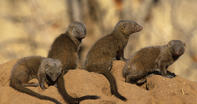
Name
Common dwarf mongoose (helogale parvula)Appearance
Being the smallest of the mongoose family, both males and females weigh about 350 to 400 g. They measure 18 - 28 cm in length with a tail nearly as long as its body. Varying from dark chestnut to a light brown, their coats are uniform in colour. The common dwarf mongoose only reaches maturity at the age of two years.Common Dwarf Mongoose Diet
The common dwarf mongoose feeds on invertebrates such as grasshoppers, termites, beetles and their larvae, which they scavenge and dig from the ground. At times they take small vertebrates as prey. While foraging, their troop members remain vigilant to predators.Breeding
After a gestation period of about 63 days, the gravid female births a little of 2 - 3 young. Breeding mainly during the rainy season, an alpha female can give birth to 2 - 3 litters per year. Only the dominant pair within the troop will breed, the rest of the pack help in rearing and fending for the young.Dwarf Mongoose Behaviour
The Shangaan name for dwarf mongoose is “machiki-chorr” an onomatopoeic name that refers to their constant vocalizations. These develop from contact peeps to churrs, twitters and rolling chatters as different stimuli and situations take place.
The dwarf mongoose vocabulary includes subtle changes in sounds to denote different kinds of predators, e.g. aerial vs. terrestrial threats, and may even indicate to the group the nearness of a given threat. This differentiation is necessary because being small animals they are virtually defenceless against aerial predators and must rely on darting into cover to overcome these threats.
Some terrestrial threats can be dealt with through group cooperation and mobbing attacks. Once the alarm is given, a group of mongoose will freeze as an initial response. This allows them to escape detection through lack of movement, a stimulus used by many predators to catch prey.
They may then rise up onto their hind legs using the tail as a prop, in order to have a better look around. When the members of the group are satisfied that the threat is no longer pending, they will continue feeding. If imminent danger looms, the pack will dart for the nearest bolt holes, of which they have an intimate knowledge within their territories.
Dwarf mongoose, especially the alpha male, are renowned for their brave rescue attempts to retrieve captured members. By Megan Emmett
Where are Dwarf Mongoose Found
The common dwarf mongoose prefers dry woodland savanna as their habitat. They can be found in the most southern reaches of North West, Limpopo, Mpumalanga and northern KwaZulu-Natal Provinces of South Africa.Spoor Description
The common dwarf mongoose has long, sharp and curved claws on its front feet measuring about 10 mm that are well adapted to digging. The claws on the hind feet are shorter, measuring up to 8 mm. The common dwarf mongoose leaves a variety of spoors.
Its forefeet have 5 toes, the first toe being small and lying behind the intermediate pad. The first toe and proximal pad of the front feet show when the animal is moving slowly, but not when it is running or trotting. The hind feet have five toes each, the first being behind the other four toes and only showing its claw.
 Dwarf mongoose utilize homeranges of about 1 km². Within the area, they require a network of termite mounds, with exposed ventilation holes...
Dwarf mongoose utilize homeranges of about 1 km². Within the area, they require a network of termite mounds, with exposed ventilation holes... Dwarf mongoose are the smallest carnivores found in the Lowveld. They are also often the most numerous carnivore found in the bush due to th...
Dwarf mongoose are the smallest carnivores found in the Lowveld. They are also often the most numerous carnivore found in the bush due to th... Dwarf mongoose are accomplished hunters and use many different techniques to capture their prey which comprises mostly of insects but includ...
Dwarf mongoose are accomplished hunters and use many different techniques to capture their prey which comprises mostly of insects but includ... Dwarf mongoose are extremely social cooperative breeders and within their community, they show great organization of roles. The group is dom...
Dwarf mongoose are extremely social cooperative breeders and within their community, they show great organization of roles. The group is dom...